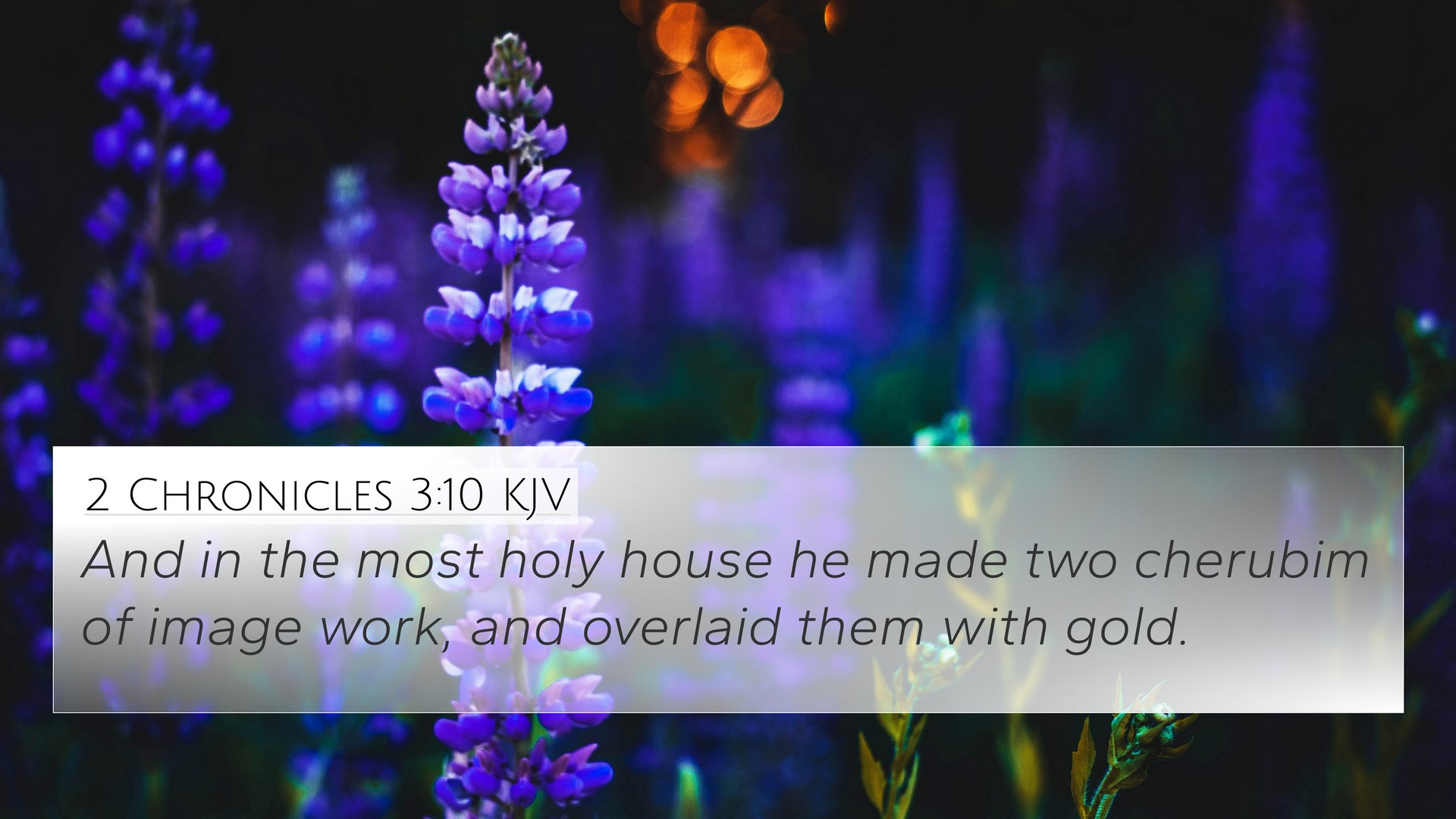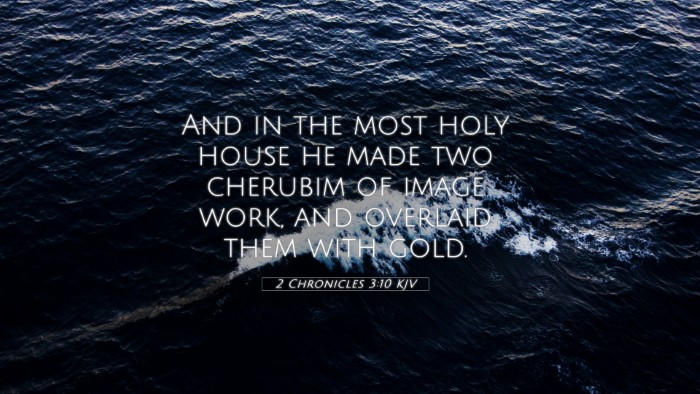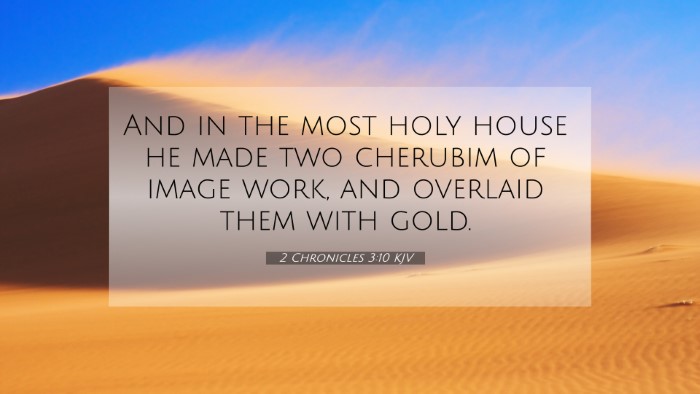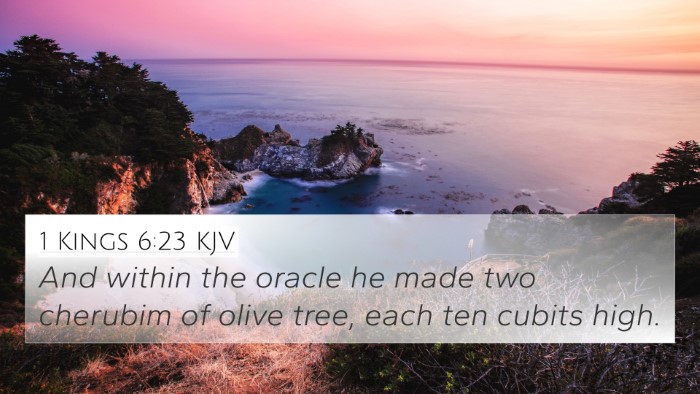Understanding 2 Chronicles 3:10
2 Chronicles 3:10 states:
"And in the most holy house he made two cherubims of image work, and overlaid them with gold."
This verse is pivotal in understanding the glorious temple Solomon built for the Lord, specifically the significance of the cherubim and their symbolic representation in the context of God’s presence and holiness.
Commentary Insights
The key themes from public domain commentaries provide a deeper understanding of this scripture. Below are insights sourced from notable commentaries:
Matthew Henry's Commentary:
Matthew Henry highlights that the cherubim symbolize the majesty and holiness of God. Their placement in the most holy part of the temple indicates God’s dwelling among His people and the importance of reverence in approaching Him. Henry elaborates on the craftsmanship of these cherubim, emphasizing that the skill involved reflects the awe-inspiring nature of divine worship. The cherubim serve not only as guardians of the Holy presence but also as a reminder of God’s covenant with His people.
Albert Barnes' Notes:
Albert Barnes emphasizes the importance of cherubim as symbols of divine presence and protection. He notes their elaborate design and gold overlay exemplify the beauty that should accompany worship. Barnes connects this with the sacrificial system, where the cherubim are indicative of the way God invites humanity to enter into his holiness through worship. He links this verse to the deeper theological underpinnings present in Exodus and the purpose of the temple as a dwelling place for God.
Adam Clarke's Commentary:
Adam Clarke draws attention to the significance of the number of cherubim, indicating that their duality highlights the completeness of God's presence. Clarke discusses the craftsmanship involved in the cherubim's creation, illustrating how the finest materials were used to honor the sanctum’s sacredness. He also treats this verse as part of a broader narrative regarding the construction of Solomon's temple, symbolizing the glory of God and His approachability through worship.
Thematic Connections
The verse connects with various biblical themes and narratives, indicating the interconnectedness of scripture. Below are notable cross-references:
- Exodus 25:18-20: Discusses the original instructions for making cherubim for the Ark of the Covenant.
- 1 Kings 6:23-28: Provides additional details about the cherubim made for Solomon’s temple, contributing to a comparative analysis.
- Psalms 80:1: References God’s presence between the cherubim, reinforcing their symbolic importance.
- Ezekiel 10:1-2: Describes cherubim in a prophetic vision, linking them to God's glory and divine judgment.
- Hebrews 9:5: Mentions the cherubim as part of the mercy seat, emphasizing their role in the heavenly sanctuary.
- Revelation 4:6-8: Depicts living creatures akin to cherubim, showing continuity in biblical symbolism of divine beings.
- Genesis 3:24: Describes cherubim guarding the way to the tree of life, indicating their protective function.
- Isaiah 37:16: Calls upon God who dwells between the cherubim, reaffirming their connection to God’s presence.
- Daniel 9:20-21: Illustrates prayer and divine revelation involving celestial beings, connecting to the temple’s significance.
- Luke 1:19: The reference to angels present at God’s throne reflects the continuous theme of God’s interaction with humanity.
Application and Reflection
Understanding 2 Chronicles 3:10 enriches our view of the temple of God and the importance of worship. Cherubim represent a bridge between the divine and human realms, urging believers to recognize the sanctity of God’s presence and the call to approach Him with reverence. As we engage in our own spiritual practices, reflecting on these symbols deepens our comprehension of God’s nature and our relationship with Him.
To incorporate these insights into a comprehensive study, believers can utilize tools for Bible cross-referencing such as a Bible concordance or cross-reference Bible study methods to explore further connections and enrich their understanding.
Conclusion
2 Chronicles 3:10 encapsulates significant themes about God's holiness, the beauty of divine worship, and the complexity of inter-Biblical dialogue through cherubim. By utilizing comparative Bible verse analysis and cross-referencing biblical texts, believers can gain greater insights into the multifaceted nature of God's revelation and His relationship with humanity.




